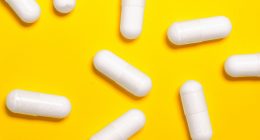UV-visible spectroscopy is the quantitative method of absorption spectroscopy in the UV and visible regions of electromagnetic radiations. The spectroscopy is a branch of science that involved the study of the interaction of electromagnetic radiations with matter. Depending upon the nature of interaction between the electromagnetic radiations and the matter several possible processes can take place such as absorption, emission, elastic scattering, and inelastic scattering.
The range of UV radiations is in 200-400nm, while range of visible region is 400-800nm. UV-visible spectroscopy is essentially used for quantitative analysis and serves as a useful auxiliary tool for structural elucidation.
ORIGIN OF UV-VISIBLE SPECTRA
- A UV-visible spectroscopy records the degree of absorption by sample as a function of wavelength of light absorbed and resulting plot between absorbance versus wavelength is known as UV-visible spectrum.
- UV- visible spectrum arises due to transition of electrons from ground state to excited state due to absorption in uv and visible spectrum in the electromagnetic regions.
- Electronic transition can take place from σ to σ* or 𝜋 𝑡𝑜 𝜋∗ or n to σ* depending upon the nature of the molecule.
- Transition from σ to σ* requires a highest energy and take place at a shorter wavelength, while transition from n to π*requires a least energy and hence take place at longer wavelength.
- The part of molecule or group of atoms which is responsible for absorption is called chromophore and the group attached to chromophore that can change absorption characteristics of chromophore is called auxochromes.
Theory of UV- visible spectroscopy
Lambert’s law: this law states as follows:
When a beam of light is allowed to pass through sample the absorption of light is directly proportional to path length of light within the sample of substance.
Mathematically, the Lambert law states that:
A ∝l o
Log I0/I∝l
Where,
- A is a absorbance
- l is a path length of light in sample in cm
- I0 is a intensity of incident light
- I is a intensity of transmitted light
Beer’s law: this law gave the relationship between the absorption of light and concentration of absorbing material. According to this law, when a beam of electromagnetic radiations passes through the absorbing material dispersed in a non absorbing solvent than the absorption of radiations is directly proportional to concentration of the absorbing material.
A ∝c
Or, log IO/I∝c
Where,
- A is a absorbance
- C is a concentration of sample
- IO is a intensity of incident light
- I is a intensity of transmitted light
General absorption law for UV-visible spectroscopy is a combination of beer’s law and Lambert’s law known as beer- Lambert law. Lambert’s law shows that there exists a logarithmic relationship between the transmittance and therefore the length of the optical path through the sample. Beer observed that a similar relationship between transmittance and the concentration of a solution.
Log IO/I ∝l.c
Or, log IO/I= ε.l.c
- Where, e is a constant and known as molar absorptivity.
- A= ε.l.c where, A= log IO/I simply known as absorbance.
INSTRUMENTATION OF UV-VISIBLE SPECTROSCOPY
The UV-visible spectroscopy have the following basic components:

- Radiation source: a continuous source of radiant energy covering the region of spectrum in which the instrument is designed to work. The most commonly used radiation sources in UV-visible spectroscopy are hydrogen, deuterium lamps, the xenon lamps, and mercury arcs. In all sources, excitation is done by passing electrons through a gas and these collisions between electrons and gas molecules may results in electronic, vibrational and rotational excitation in the gas molecules. The following requirements of a radiation source:
- It must be stable
- It must supply continuous radiation over the whole wavelength region during which it’s used.
- It must be of sufficient intensity for the transmitted energy to be detected at the topa of the optical path.
2. Monochromators: the monochromator is employed to disperse the radiation consistence with the wavelength. Monochromator converts polychromatic light into monochromatic light. The essential elements of a monochromators are an entrance slit, a dispersing elements and an exit slit. The dispersing element could also be a prism or grating. The prisms are generally made from glass, quartz or fused silica. The purpose of prism is to convert polychromatic light into 7 parts (VIBGYOR).
3. Cells: the cell holding the sample (usually a solution should be transparent to the wavelength region) being recorded. For visible region they are made of color-corrected fused glass. The thickness of the cell is generally 1cm. cells may be rectangular or cylindrical in shape or cylindrical with flat ends. A variety of sample cells are available for ultra violet and visible wavelength regions. The choice of sample cells is based on :
- The transmission characteristic at the desired wavelength.
- The path length, size and shape
- The material of construction should be inert to the solvent.
- The relative expenses
- The transmission characteristics at various wavelength depends upon the construction material. Glass and plastic may also used in the visible, whereas KBr or some salt like material is necessary in the infrared.
4. Detector: the main function of detector is to continuously measure the intensity ratio of the beams transmitted through sample cells and reference cell. There are commonly three types of detector which are widely used in UV-visible spectroscopy. The detector used in UV-visible spectroscopy is generally photo multiplier tube, although in some instruments photo diodes are also used.
- Barrier cell
- Photomultiplier tube
- Photocells
5. Recording system: the signals from detector are fully received by the recording system. It automatically records the absorption of light at each wavelength as graph of absorbance versus wavelength.
APPLICATIONS OF UV-VISIBLE SPECTROSCOPY
- Detection and analysis of drugs of abuse
- Determination of alcohol in blood
- Ink analysis
- Determination of metals
- Analysis of blood stains
- Discrimination of dyed textile fibres
- Analysis of carboxyhaemoglobin in blood sample.
For more spectroscopic technique, subscribe to our blog.





